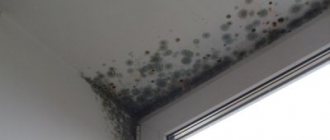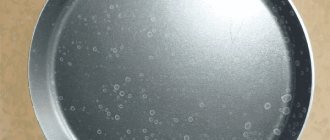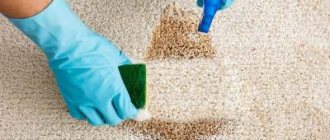Issues discussed in the material:
- What are the reasons for the formation of white sediment in water during boiling?
- How white sediment in water affects the human body
- How harmful is white sediment in water for household appliances?
- How to improve the quality of water from a well that produces white sediment
- How to Get Rid of White Sediment in Well Water
In most cases, white sediment in water occurs due to a high concentration of salts of various chemical elements, including iron, magnesium, calcium, otherwise called hardness salts. Increased water hardness is indicated by the presence of scale and sediment in water heating appliances (kettles, washing machines and dishwashers), a film on the surface of tea or coffee, and white flakes at the bottom of the container. Using such a liquid for drinking or for household purposes is inconvenient and is fraught with a number of negative consequences, both for household appliances and for human health.
Why does a white coating appear on the surface of water after boiling?
First of all, you need to know what exactly your filter filters out.
The fact is that some filters completely remove dissolved salts from the water, and the result is essentially deionized (or distilled) water. Nothing can happen to it when boiled. But if the filter does not remove hardness salts (mainly calcium bicarbonate Ca(HCO3)2), then when boiled (generally when heated) it decomposes into calcium carbonate, carbon dioxide and water Ca(HCO3)2) ——> CaCO3 + H2O + CO2. Calcium carbonate is a white salt (chalk) and insoluble in water. Some of it precipitates in the form of scale on the walls or bottom of the kettle. But tiny bubbles of carbon dioxide can “stick” to some small crystals. Then the average density of the crystal becomes less than the density of water, and it floats to the top. If you mix well, the bubbles will come off and the coating will sink. The filter does not help because magnesium and calcium bicarbonates are soluble in water. But when boiled, bicarbonates turn into carbonates, which precipitate in the form of white flakes or deposits. And since our water supply is quite hard, which is due to the high content of carbonates.
Reasons for appearance
The abundance of minerals in water leads to the fact that after boiling they settle to the bottom and walls of the container as a white sediment. Common culprits include excess quantities:
- magnesium;
- potassium;
- gland.
The level of hardness depends on the concentration of mineral elements in the liquid. Soft moisture is called moisture whose parameter is not higher than 3 mEq/l, medium - up to 6. In hard water, after analysis, the indicator exceeds 6.5 mEq/l (10-15).
Reasons for the problem Source educatiepentruviata.ro
Due to the deterioration of city highways, mineral salts in the form of white sediment easily penetrate into apartments. Bursts in pipes lead to the appearance of foreign elements in the water. In private homes, contamination of liquid in wells occurs due to a violation of the well’s tightness. Lime or clay penetrates through the shifted rings, which leads to a deterioration in the chemical composition.
Why does a white precipitate occur? Source stav-reporter.ru
Even visually pure moisture when boiling leaves a residue on the walls of electrical appliances and dishes. The presence of elements in a humid environment and the connection with each other leads to oxidation, which provokes the appearance of a white precipitate in drinking water. Often lime, clay, sand penetrate through the mechanical filter, spoiling the composition.
The harm and benefits of boiled water
During thermal exposure, the liquid is subjected to high temperatures. As a result, all harmful bacteria and microorganisms that are completely unnecessary for the human body die. Also, boiling destroys complex chemical compounds, such as chlorine and its derivatives. In this case, salts and various impurities are formed, which a person separates from drinking liquid. This is what helps protect the body from harmful effects.
No matter how much a person would like it, during the thermal treatment of water, viruses and pathogenic bacteria are not completely removed. Some microorganisms require prolonged boiling. Few people wait 10-20 minutes after the seething surface appears. Most electric kettles turn off on their own. Because of this, many bacteria remain in the drinking liquid, which are more harmful than those that evaporate.
Is Water After Boiling With White Plaque Harmful?
As for air bubbles, this phenomenon is observed while the modules are new and will pass over time. The modules consist of carbon carbon blocks and in order for the entire surface of the module to be saturated with water as quickly as possible, the following procedure must be done: open the faucet on the sink so that water flows in a thin stream; you can adjust the stream using the connection unit (under the sink) to the water supply or the tap on the sink . It is necessary to drain for 20-30 minutes in a stream as thick as a match.
“Are hardness salts dangerous”? Dangerous. Spurs in the heels, stones in the kidneys and bile ducts, three-knock joints, after the onset of the 4th stage you will not walk at all, from the word AT ALL, all kinds of chondrosis, i.e. deposits of excess salts on the tips of the vertebrae, which will put pressure on the nerve endings, causing extreme pain. Drink only soft water. Get everything you need from, preferably, natural products. I wish you health and longevity. Best regards, Olga.
We recommend reading: Actions of a Security Guard Upon Detection of Theft by a Trade and Materials Employee
White water
Water acquires its milky white color due to the high concentration of dissolved air bubbles in it. This reason is easy to check. Let the water settle
2-3 minutes. If transparency has not returned or sediment has appeared, this is a reason to further determine the causes of cloudiness in the water.
Most often they can see water of the above two colors. Below you will learn about the “palette” that colors the water in taps connected to water sources in rural areas, country and cottage communities.
White sediment in the water indicates that it is too hard.
Typically, a white precipitate in water is formed due to the presence in it of a large amount of salts of iron, magnesium, calcium, that is, hardness salts. Scale and sediment in water heating devices (in a kettle, for example), film on tea, white flakes - all this is considered a sign of too hard water. And if you use it for household needs, it will cause a lot of inconvenience.
Too high water hardness, from the point of view of the science of chemistry, is a combination of physical and chemical processes associated with the presence in it of salts of alkaline earth metals in dissolved form, mainly magnesium and calcium. Ferric iron and aluminum also have an effect on the formation of white precipitate, but at a pH level that does not exceed the natural one, their solubility and effect on increasing hardness are not too high. Also, the influence of barium should not be taken into account, since it is negligible.
Fighting methods
Changes in water hardness can be determined after laboratory analysis of the liquid. Based on the results of the study, experts often make recommendations to minimize the problem. Among the methods of disposal, we will consider 8 popular ones.
Boiling
A method of combating white sediment in water, which is used in hard moisture. The technology makes it possible to soften liquids for drinking and cooking. The advantages of the method include:
- Destruction of the structure of mineral salts. When the water temperature increases to 100 C, sulfates and carbonates precipitate, which allows you to get rid of impurities.
- Disinfection. After boiling, microorganisms in the water die.
- Volatilization of organic compounds. Components with low boiling points evaporate.
In order for the liquid to be suitable for use, the moisture must be separated and carefully filtered from the sediment. After heat treatment, water cannot be stored for longer than a day, otherwise viruses and bacteria will be transferred from the air. In boiled liquid, the concentration of salts increases, which are deposited on the walls of the kettle or pan. If you do not destroy the plaque, the equipment or utensils will quickly become unusable.
How to clear water from plaque Source twimg.com
Freezing
Clean water freezes faster than the option with white sediment. After freezing, liquid remains inside the container, which is drained. After defrosting the ice, structured, soft moisture is obtained, which is beneficial for human and animal health.
The method is very complex and troublesome, so it is not always suitable for constant use at home. To obtain water without white sediment, you need a large tank and a powerful refrigerator. If you pump inaccurately, insoluble salts will get into the defrosted liquid.
Thermal method of removal Source nevseoboi.com.ua
Chemical softeners
Manufacturers of household chemicals offer special substances to combat white residue on dishes and appliances. Descaling products will cope with hard deposits on the walls of a kettle, coffee maker or iron. Softeners for washing machines and dishwashers minimize the negative impact of hard liquids on device parts.
Folk remedies
Chemical or natural substances will help neutralize the destructive effects of mineral salts. A combination of baking soda and citric acid is used to remove white sediment from well water. The method should not be used for cooking or drinking, and the liquid is suitable for household needs.
Decoctions of plants (nettle, flax, chamomile) will help reduce the hardness of moisture for hygiene procedures. Herbal infusions have a positive effect on the structure of the skin and hair, minimizing the negative effects of water with white sediment. The method will not replace pure moisture, but if the well is saline, it will relieve the destructive effects of chemical components.
Folk methods of water softening Source avrorra.com
Oak bark with silicon is a proven way to soften hard liquid from a well or tap. The stones are placed at the bottom of the tank, which is filled with water and left for a week. Wood residues are used for disinfection. White sediment accumulates at the bottom of the container, so carefully drain it.
Why does a white coating appear on the surface of water after boiling?
Before you find out what the harms and benefits of boiled water are, you need to say a few words about the processing of this raw material. Most often, thermal effects on liquid occur in a teapot. Boiling can also be done in a saucepan. In this case, the temperature of the liquid should reach one hundred degrees. After on.
Perhaps everyone knows that scale needs to be removed from the walls of a kettle. But few people suspect that this sediment is only the visible part of the “iceberg.” Scale is not as scary, experts say, as its cause is hard water and the harmful elements that it carries that do not precipitate in the form of scale.
Preventing scale from appearing in a kettle
It is impossible to prevent sediment from appearing in the kettle. However, by using certain prevention methods, it is possible to reduce the harm that such plaque causes to the device and the body.
For this it is recommended:
- Drain off the remaining water. Repeated boiling promotes the formation of a white coating.
- Before each use, rinse the kettle with warm water.
- Pour purified or settled drinking water into the kettle.
- Clean the device periodically with soda or citric acid.
For prevention purposes, it is also recommended to pass water through a specialized filter. The latter will not remove all calcium and magnesium salts, but will prevent chlorine from entering the device.
Scale always forms in a kettle for natural reasons. Such sediment does not cause serious harm to the body, provided that the deposit is regularly cleaned off. If you constantly drink water from a kettle that contains scale, this can lead to the development of diseases.
It’s real to defeat white sediment in water – 5 proven ways
Temporary – carbonate hardness, is associated with the presence in water (at pH>8.3) of calcium and magnesium bicarbonates – Ca(HCO3)2, Mg(HCO3)2. If we increase the temperature of such water, unstable bicarbonates turn into an insoluble form, that is, carbonates CaCO3↓ and MgCO3↓ are formed, while carbonic acid is released, and a white precipitate is formed in boiled water, in other words, scale, boiler stone. This type of hardness can be almost completely eliminated by boiling water, which is why it is called temporary.
In addition, water hardness is divided into permanent and temporary. This indicator depends on the type of salts. The second option is associated with the presence of water-soluble salts in water. They disintegrate when the liquid is heated - when a kettle or washing machine is used, a white precipitate forms in the water. It is clearly visible to the naked eye and after a certain time becomes the cause of breakdown of household appliances.
White sediment in water after boiling
Are there any ways to purify water from bioG. dissolved in water? For example, in a well, a frog can die and stink, and a bunch of insects, and all kinds of silt, and mucus on the stones. And there is no need to talk about the sterility of water supply systems, and if this issue is investigated, then, probably, you will completely stop drinking such water. Will only a distiller help?
Probably the most natural and effective way to purify water is by natural method, through the formation of condensate and its subsequent collection. Having rummaged around on the Internet, I found interesting options for solar water purifiers (desalinizers) for the summer season, which allow you to get the purest water for free, using the energy of the sun and without any pressure: » > » > It’s a pity that they don’t sell ready-made such devices, I would buy
We recommend reading: Transport tax on bus groove 32 0 53
Sediment from boiling water, how to get rid of it
To get rid of sediment, you need to boil soft water. To get it you need to install a softener in the apartment. Another affordable way to eliminate white sediment in water when heated is to boil store-bought liquid. But it is too financially expensive to cook with and drink from it all the time. Purchasing a softening device, even two, will ultimately cost less.
In industrial processes such devices are very valuable. It is extremely important to prevent scale formation there, otherwise the heating and water supply system may fail, and houses may be left without heating, not to mention without water. Moreover, most industrial enterprises do not require potable water quality. With the exception of production for the food industry.
Problems of artesian water
As a rule, all problems with well water depend on the type of soil, drilling area, and depth. And one of these problems is considered to be white sediment in the water , the reason for which is described above. To get rid of this problem, you need to install a filter system at the entrance to the house that will purify the water. But they need to be selected correctly, and this can only be done after laboratory analysis of the source water. Based on the results obtained, you can select the necessary filters. If iron, magnesium, and calcium are present in large quantities in the water, then you need to install filters to remove iron and soften the water. The latter will also help get rid of the white sediment.
White flakes in water after boiling
If you see a white precipitate when boiling water, know that such a liquid cannot be useful to the same extent as a soft one. Soft water has a very large number of advantages compared to hard water. This applies both to everyday needs and to the quality of life of people in general:
— Household filters purify water from harmful impurities and bacteria, but cannot return its beneficial natural qualities. I am often asked how I feel about magnetizing water? Can this method really erase negative information and fill purified water with vital energy? The magnetic field that affects water changes its physical and chemical properties. There is scientific confirmation of this. The water becomes more structured than ordinary water. It increases the rate of chemical reactions and crystallization of dissolved substances. For example, hard magnetized water does not form sediment on the walls of steam boilers - this does not slow down its thermal conductivity, because scale does not form. Boiler houses have long used patented devices for magnetizing water. There are also special magnets that are inserted into the filters of drinking water purification systems for a healing effect. Of all the technologies for “vitalizing” water, the magnetization method is considered the most scientifically based. However, the “memory” of magnetized water is short-lived - up to two days.
Solutions
The cleaning method is usually proportional to the type of contamination to be removed. So, to get rid of water hardness and reduce the level of, for example, strontium in it, a different approach will be required. Removing the white tint is solved: a) by cleaning the accumulated sediment by blowing (cleaning) the water heater; b) after the accumulation of a certain amount of sludge; c) purification by reverse osmosis filtration to the state of potable moisture; d) gas removal using aeration with degassing.
Of course, of the huge number of inclusions dissolved in a liquid, only a few of them can be identified visually. And if the water, after settling, leaves a sediment of white suspension at the bottom, this will be evidence of the proximity of the source to limestone and calcium salts.
Filtration and purification are carried out competently if qualified specialists who are proficient in this subject are involved in the process, and not amateurs.
byrim.com
Why does white sediment appear in boiled water?
- Due to the hardness of tap water and all sorts of impurities, when it is boiled, a white precipitate and scale form. It can very often be seen in the kettle at the bottom and scale on the walls. Tap water must be filtered, then the sediment problem will disappear
- It even happens that water was collected from the tap, then filtered, and then boiled, but there is still a white precipitate. The fact is that different filters (especially the simplest jugs) clean from different compounds (in general, almost all, but each impurity is removed to a greater or lesser extent).
If sediment remains, it means that the filter softened the water, but did not completely remove salts, calcium and magnesium .
Boiling alone does not get rid of harmful impurities at all, but only kills bacteria.
- Our tap water is of such good quality, and even filtration does not always help, white nalt is scale that forms as a result of heating water, sometimes it is bleach, which is still used to purify our water, although this method of purification has long been used in the whole world prohibited
- I think that the water you use contains a lot of trace elements and iron, which give a white precipitate when boiled. It is very good to have a water filter at home and clean the kettle more often so that scale does not accumulate on its walls and bottom.
- When boiled in water, lime and other minerals and chemical elements crystallize and settle on the walls and bottom of the kettle. To clean the kettle, you need to pour a little vinegar into the kettle with water and boil it, then rinse the kettle with clean water.
- Running water from a tap has increased hardness due to the presence of various impurities and even just rust and other things from old pipes. Even after filtering with a pitcher, flow-through or other conventional apartment filter and subsequent boiling, some scale remains.
- Boiling is the process of heating water to the point of steam formation (100 degrees), during which the process of forming steam bubbles occurs due to the fact that as the temperature increases, the steam pressure increases and they float up. During the boiling process, a sediment is formed, which includes dirt particles, heavy elements and beneficial salts of calcium and magnesium.
- This is a type of scale, it’s just that the poorer the quality of the water, the more sediment it leaves, and it can come in all sorts of flakes and sand and even green deposits, so you should first pass the tap water through a filter, and only then boil it and eat it.
- Even filtered boiled water can produce sediment, and this is quite normal, it depends on the hardness of the water; the harder the water, the more sediment there will be. When boiling water, magnesium and calcium bicarbonates are destroyed, turning into carbonates. And these carbonates do absolutely no harm to human health.
- If a white precipitate appears in your boiled water, it means your water is hard, and this is the same scale, various suspensions and minerals. We don’t have this, but our water is very soft, but when I went on vacation to a sanatorium, the water there was bad, and such phenomena were noticed in it after boiling. I had to drink water from the cooler.
info-4all.ru
Perhaps everyone knows that scale needs to be removed from the walls of a kettle. But few people suspect that this sediment is only the visible part of the “iceberg.” Scale is not as scary, experts say, as its cause is hard water and the harmful elements that it carries that do not precipitate in the form of scale.
Scale is the deposition of mineral salts contained in water after it is heated or boiled. Any housewife will be happy to share a lot of ways to get rid of this white coating, but we hardly think: why and what exactly is so dangerous about the resulting sediment? Experts say that scale is just an indicator and a consequence of a high degree of water hardness. The scale itself is quite easy to remove using modern means or “grandmother’s” methods. but you need to fight not with the effect, but with its cause.
It is known that the degree of water hardness is determined by the level of mineral salts in it, which are commonly called hardness salts. Science divides water hardness into temporary and permanent. Temporary is determined by calcium and magnesium salts, which, when boiled, precipitate, that is, they form scale. The level of permanent hardness depends on the concentration of calcium and magnesium salts that remain in the water even after boiling, for example, calcium sulfate or calcium chloride. It is salts of constant hardness that, under certain conditions, precipitate in the human body and form real scale in it, which is not as easy to get rid of as “flakes” on the walls of a kettle.
At the same time, such salts can be deposited in almost any organ - from the gallbladder to the joints. Considering that we use water in one way or another to prepare most foods and dishes, the benefits of hard water for the body are, to put it mildly, questionable.
Scientists, however, are in no hurry to blame water distribution organizations for all the troubles. The existing standards for water hardness in Russia are the same for all regions. But, according to experts, the actual degree of hardness depends solely on the natural conditions of water mineralization in a particular area. That is why the standards allow double - minimum and maximum - indicators of hardness and iron content in water in case of their increase. Moreover, artificially reducing the level of rigidity leads to rapid corrosion of pipes. At the same time, soft water contains more iron and those metals that are washed out of the pipes themselves and enter our household taps with water, and from there into the body. Reducing water hardness at the level of distribution networks is also economically unprofitable and unjustified, and not only in Russia, but throughout the world. It is estimated, for example, that of the 300-400 liters of water that we use daily, 99 percent is used for domestic needs. Economists and scientists agree on one thing: the task of water distribution organizations is to provide us with bacteriologically and toxicologically safe water.
But the average consumer has to think about how to get truly high-quality water from this safe water and thereby take care of their health.
This is where household water filters come to the rescue. Modern Russian technologies in this area, by the way, have long been superior to Western ones. A standard household filter, such as Aquaphor Crystal, not only removes suspended matter, chlorine, heavy metals and other harmful impurities from water, but also gets rid of deadly scale. Manufacturers have also been producing special filter models for hard water for a long time. But in most regions of our country the water is still hard.
www.goagetaway.com
AP expert - about research of Amur water and available methods for its purification
05/01/2015, 06:14Health
— Valentina Alexandrovna, you know everything about our water! How do you assess the quality of bottled water that is delivered to our homes in 19-liter bottles?
— If the water is taken from artesian sources and meets the requirements of drinking water supply, then it is of the best quality. Drinking water comes in different categories, the highest is from natural sources. It meets all standards and can be consumed raw. After all, it undergoes special training before bottling. In terms of chemical composition, this water is the most balanced. We tested the water from our local producers many times - in principle, it all met the requirements.
But when you buy water, be sure to look at what source it comes from. For example, the highest category includes water taken only from underground wells. You can bring tap water to a certain standard, but it will still be superficial.
- How is she worse?
“Such water collects industrial and agricultural waste from the surface of the earth and passes through the information fields of the planet, which negatively affects its quality. Water from a well and especially artesian water is in any case better than river water.
— What kind of water flows from the taps of residents of the regional center?
— The Amur water intake takes water from the river. Of course, it is cleaned and brought to a certain condition, but no matter how hard they try, it still has a certain taste and smell - this indicates the imperfection of cleaning technologies. The northern water intake takes under-channel water from the Zeya River. This is underground water, but not artesian. Our tap water does not fully meet all drinking water quality requirements. People feel it organoleptically. As they say in common parlance, water is not very tasty.
— I read on one of the websites that “the content of iron in tap water in the Amur region is up to a hundred times higher than the permissible concentrations” (MPC), is this really true?
— There is definitely no such thing in the city water supply network. But in many wells that residents of the private sector drill for personal consumption, the iron content in the water can indeed be very high - tens and even hundreds of times higher than the maximum permissible concentration.
- Can this be visually determined?
- Yes. When standing in air, such water gives a characteristic yellowish sediment, and an iridescent film appears on the surface of the water. If these signs are absent, but a brown coating remains on the walls of the kettle after boiling, it means that the maximum permissible concentration for iron is exceeded, but not by much.
Another problem for the Amur region is that we have a lot of calcium and magnesium ions in groundwater. These are salts that determine water hardness. It doesn't lather well, and after washing, a flaky residue forms on the walls of the basin. There are definitely no health benefits from such water. Such water can only be used for technical needs, and for drinking it must be purified.
— Many people notice that water from bottles leaves white flakes after boiling. What could this mean?
— Boiling is one of the ways to eliminate temporary hardness, that is, when boiling, calcium and magnesium carbonates are formed. Visually, the water becomes cloudy and a light white sediment appears. This is where excess calcium salts settle to the bottom. There's nothing wrong with that. But boiling by itself does not improve water quality. If, for example, you boil tap water that contains residual chlorine, chlorine-containing organic compounds are formed - a powerful carcinogen. Boiling unsettled tap water, especially repeatedly, is very harmful!
“I used to draw water from a consecrated spring in the Belogorye area, but then I stopped - the bottle began to become covered with a green coating.
— Natural water cannot be stored in the light. The water we buy is specially treated - it is ozonated to kill all living microorganisms. Otherwise it will turn green in the light. This suggests that there are simple algae in the water, and they begin to develop in the light. Their waste products worsen water quality, especially if the algae are from the blue-green family. Therefore, when you make a large supply of natural water, store it only in a dark place.
METHODS OF WATER PURIFICATION AT HOME
Filters
— Nowadays, pitcher-type filters are widespread, where the cartridge is selected depending on the quality of the water. As a rule, there are three types: some purposefully reduce water hardness, others - iron content. For residents of Blagoveshchensk, I would recommend universal ones. The water in our network is moderately soft - there are no excesses of the maximum permissible concentration for calcium and magnesium salts. But remember: filters have certain terms of use, the manufacturer indicates them. Change cartridges or cassettes regularly. Over time, microorganisms begin to develop on them, and the waste products of these microorganisms can be quite harmful. Then, in addition to chemical pollution, biological pollution will also be added. Drinking such water is even more harmful than drinking tap water.
Advocacy
— Water settling reduces the amount of free chlorine in tap water. One test for water toxicity is using daphnia or juvenile trout. They pour water, put the fry in there and see whether they survive or not. The individual amounts of each chemical element in tap water may be harmless, but exposure to several of these elements together can have a toxic effect. Even if chemists say that the water is clean: the maximum concentration limit is not exceeded for either one, or the second, third or tenth component, we put a small fish in there - and it dies. This means that in general the water is toxic—the living organism dies. In combination, all these elements give such a negative effect. Therefore, tap water must be defended - then it becomes biologically active, capable of supporting life.
MINERALS OR COALS?
“Sometimes people put minerals in carafes of filtered water, hoping that the quality of the water will improve. Indeed, some minerals have ion-exchange properties - they take some ions from the water and release others. For example, ions of iron, manganese, calcium, magnesium are replaced by potassium and sodium ions that are more harmless to humans. Ziolite and shungite have these properties and improve the composition of water. Silicon water does not have ion-exchange properties, but gives a slight bactericidal effect.
There is another popular method of water purification - birch coals. This is, in fact, the same activated carbon that is used as one of the stages of water purification in filters. It absorbs organic substances well. But I would like to warn people against this type of cleaning. In production, activated carbon is produced by burning wood in a special way - without access to air. The coals must burn well, otherwise you can get poisoned - resins from wood that are not completely burned out are very toxic.
MAGNET IMPROVES WATER PROPERTIES
— Household filters purify water from harmful impurities and bacteria, but cannot return its beneficial natural qualities. I am often asked how I feel about magnetizing water? Can this method really erase negative information and fill purified water with vital energy? The magnetic field that affects water changes its physical and chemical properties. There is scientific confirmation of this. The water becomes more structured than ordinary water. It increases the rate of chemical reactions and crystallization of dissolved substances. For example, hard magnetized water does not form sediment on the walls of steam boilers - this does not slow down its thermal conductivity, because scale does not form. Boiler houses have long used patented devices for magnetizing water. There are also special magnets that are inserted into the filters of drinking water purification systems for a healing effect. Of all the technologies for “vitalizing” water, the magnetization method is considered the most scientifically based. However, the “memory” of magnetized water is short-lived - up to two days.
- Irina Voroshilova
- Amurskaya Pravda from 04/24/2015
ampravda.ru
Is sediment in a kettle harmful to humans?
Getting rid of scale is easy. There are many chemicals, but the cheapest and most effective method is food grade citric acid. 100 grams of powder should be diluted in a liter of water and poured into a kettle. After boiling for several minutes, you will need to let it sit for an hour, then pour out the solution and rinse with clean water.
If a small amount of plaque particles enters the body, nothing catastrophic will happen. If this is a system, then this can become a problem for a person. Dissolving in the stomach, salt compounds penetrate the blood, move through the vessels and enter other internal organs. This reaction is called reabsorption in medicine. This leads to the accumulation of excess salts in the joints, blockage of blood vessels and even the formation of stones in the bladder and kidneys.
Why is it important to descale your kettle?
The scale that appears must be removed, since this plaque creates a favorable environment for the development of pathogenic microflora. Bacteria can penetrate tea or other drinks, along with which they enter the human body. In addition, a high salt content in water provokes the development of various pathologies:
- urolithiasis disease;
- gout;
- plaque;
- osteochondrosis.
These complications arise under the condition of constant consumption of water with a high concentration of calcium and magnesium salts.
Limescale is also dangerous for an electric kettle, as it shortens the service life of the device. In such devices, a heating element is used for heating. It is on this element that the first deposit forms. As the layer of plaque increases, the energy consumption used to heat the kettle increases. This leads to overheating of the heating element and breakdown of the device.
How to remove white deposits from glass containers after boiling without compromising sterility
If you want to sterilize jars by boiling, then sediment will appear to one degree or another in any water other than distilled water. These are salts, it’s difficult to get rid of them completely, and if you forget the jars a little, then there will be a small deposit based on the level at which the water filled the jar. This is actually scale or limescale. In principle, you can try adding a little citric acid to the water. But in my opinion, it is easier to sterilize the jars with steam over a saucepan on a special grid with holes, where the jars are lowered with their necks down.
We recommend reading: School Troika
Try filtering the water first and then boiling it. It is better to use filters for hard water - if I’m not mistaken, there is carbon there, passing through which, salts and rust settle and no longer get into the water. The main thing is to choose the right filter.
Why does plaque form on the bottom and walls of dishes?
The content of all necessary microelements in artesian water (such as Protera) is determined by nature itself and is under the constant control of specialists. If you keep it in a glass or ceramic container for a long time, the bicarbonates will indeed precipitate in the form of a harmless white precipitate. If you boil it, scale will appear inside the kettle. But all this is good.
The white coating that remains on the bottom and walls of dishes is very annoying for housewives. If you leave water in a dish for a long time, a deposit will form along the edge - at the level of the gradually evaporating water. It sometimes appears on teapots, aquariums and even in swimming pools.
Methods for removing white sediment from water
The easiest way is boiling and settling - all the sediment will remain on the bottom and walls. But, as stated above, this will only relieve temporary, and not permanent, rigidity. It is more effective to use household filters: jugs, three-stage systems or equipment with reverse osmosis technology. The type of filter is chosen based on your financial capabilities and the characteristics of tap water.
But purifying drinking water alone will not protect household appliances and pipes from premature failure. To soften all the water entering the apartment, main filters are used, which are built directly into the water supply at all entrances.
In private homes, the problem of water purification is most acute: it is necessary not only to achieve optimal hardness levels, but also to remove mechanical impurities, as well as heavy metals, bacteria, and viruses that may be present in the soil. Special filters for cottages allow you to purify the liquid coming from the well so that only water that is 100% safe for humans, animals and equipment enters the house. The selection of a specific solution is based on the results of water analysis and water consumption.
In the product range you will find filter systems for domestic and industrial use, depending on your needs and water characteristics.
When boiled water becomes dangerous
It is not difficult to determine excess iron in water: if, after standing in air, characteristic yellowish flakes appear in the water, this means that as a result of a reaction with oxygen, iron dissolved in water has precipitated. Another characteristic sign of the presence of iron in water is a rainbow film on the surface. It happens that the above signs are absent, but a rusty coating remains on the walls of the cookware after boiling. This means that the excess of the maximum permissible concentration for iron is insignificant, although it is present.
In different cities, water is taken from various sources: surface - rivers, lakes, reservoirs, underground - artesian wells. But in both cases, at water treatment plants, water goes through several stages of processing, depending on the chemical composition and organoleptic characteristics. Water from a well is always of higher quality than from surface sources. Surface runoff enters rivers and lakes, and even after thorough treatment, the water may have a taste and odor.
How does hard water affect your health?
White deposits on the surface of the water or floating flakes can be removed by passing the water through a fine sieve. But eliminating visible deficiencies will not help to significantly reduce water hardness, which affects the skin, hair, and internal organs when drinking and eating.
- When hard water comes into contact with the skin, it clogs pores, destroys the natural protective film of fat, causing dryness, irritation, itching, rashes and dermatitis.
- Hair and scalp also suffer from poor quality water: dandruff, split ends, fragility appear, shine and well-groomed appearance disappear.
- In the body, excess salts provoke urolithiasis, blockage of blood vessels, digestive disorders, and joint diseases.
Hard water also harms household appliances (washing machines, dishwashers, kettles, coffee makers), heating and hot water supply systems, as it shortens the life of heating elements and pipes. Plants also suffer from watering with low-quality water: excess mineralization appears in the soil, and a dense coating forms on the leaves, which interferes with breathing and nutrition.
With increased hardness, the organoleptic characteristics of cooked food noticeably deteriorate: taste and smell. When consumed in its pure form, an unpleasant aftertaste is felt; during the preparation of coffee and tea, a brown sediment and film form on the surface.
When contacting soap, hard water forms so-called “soap slag” - a deposit that is not washed off from the surface of the skin and hair. This feels like rinsing “to the point of squeaking”, but does not indicate cleanliness, but a violation of the natural protective layer.
Those who are accustomed to hard water experience discomfort when washing with soft water: the skin after washing remains as if slippery and unwashed. But these are erroneous feelings: in fact, such cleansing is much more effective and safer.
In any case, a liquid with a white sediment cannot bring as much benefit as pure soft water. The undeniable advantages of such water are the following:
- reducing the possibility of stones appearing in the genitourinary system, reducing the risks of other diseases of internal organs;
- healthier, well-groomed skin and hair;
- improving the taste of drinks and dishes;
- extending the service life of household appliances, plumbing fixtures and even clothing, since fabrics are also destroyed by hard water;
- reduction in detergent costs by up to 50%, since detergents work much better in soft water.
But it is important to remember that some hardness salts (1.5-2.5 mEq/l) should still be present. Otherwise, the body will suffer from a lack of useful minerals, and metal water supply pipes will corrode.
White deposits in the kettle after boiling
Hello dear readers of my blog











